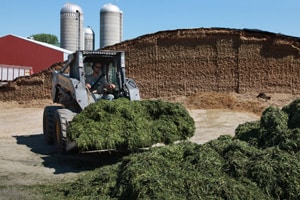AUGUST 2018

Silage is vital to the cattle industries. The smell of silage on any cattle operation brings a sense of habitual chore time activities. However, silage bunkers and silos have unique hazards, like silo gas, dust that may contain mold, avalanches, falls, and more. During the silo fermentation process lethal gasses are produced. This is especially dangerous in confined areas like around silo rooms.
Take precaution during crop production, during ensiling, and when working with silage to keep everyone on the farm safe.
SAFETY CHECKLIST
Below is a general safety checklist that applies to both silos and silage piles/bunkers. Scroll down to view custom checklists for each storage situation.
- Are you scheduling a team meeting to talk about potential safety hazards? Make sure everyone understands their roles.
- Are there signs or markings to manage traffic in the area of the silo? (packing tractors, trucks, etc)
- Do silage harvest teammates remain in their tractor/truck and wear safety vests with high visibility?
- Are you conscious of timing when working in the silage area? Silage gas is elevated for up to 10 days after storage.
- Are you using the buddy system when working around silage?
- Are you using Personal Protective Equipment (PPE) when working around silage that may contain gas? The only method for this gas is a Self-Contained Breathing Apparatus (SCBA).
- Is the storage area marked with signage?
- Is everyone trained on symptoms and how to prevent silage gas exposure, with an emergency plan in place?
You and/or your employee(s) can download and print a pdf checklist below to complete safety checks on your farm. Keep the completed forms for follow-up, future reference and inspections.
Disclaimer: The facts and information listed above are suggestions for your safety, but are in no way a comprehensive and exhaustive list of all actions needed to ensure your safety.

